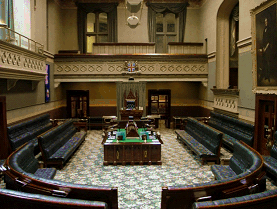The New South Wales Parliament is a bicameral Parliament, comprising two separate Houses: the Legislative Assembly, or lower House; and the Legislative Council, or upper House.
 | 
|
| The Legislative Assembly Chamber | The Legislative Council Chamber |
The practice of having two parliamentary chambers, or bicameralism, has been adopted in many legislatures including four other Australian State Parliaments, the Commonwealth Parliament, the United Kingdom Parliament and the United States Congress. The alternative model, unicameralism, relies on a single parliamentary chamber.
The basic rationale for having two parliamentary chambers is the need to avoid a concentration of power in a single body and the risk of abuse which this entails. Dividing power between two legislative chambers of broadly equal status is a safeguard against a single chamber taking extreme or excessive measures which may lack broad community support.
A further rationale for having two chambers is to ensure that the Parliament can properly perform its role of holding the government to account and checking or restraining the use of government power. In most instances, a single chamber is unlikely to be able to act as an effective restraint as the majority of its members will be representatives of the government party who vote as the government dictates. A second chamber with broadly equal powers to the first provides a more effective check on government conduct.
A two-chamber model also enhances the representative capacity of Parliament by drawing on different voting systems. In New South Wales, for example, the members of the lower House represent individual constituencies and are elected according to optional preferential voting, while upper House members represent the entire State according to a system of proportional representation. These electoral differences result in the membership of Parliament representing a wide range of different interests and views, making Parliament more democratic and reflective of the concerns of the people it serves.
More information
New South Wales Legislative Council Practice, Chapter 1.
